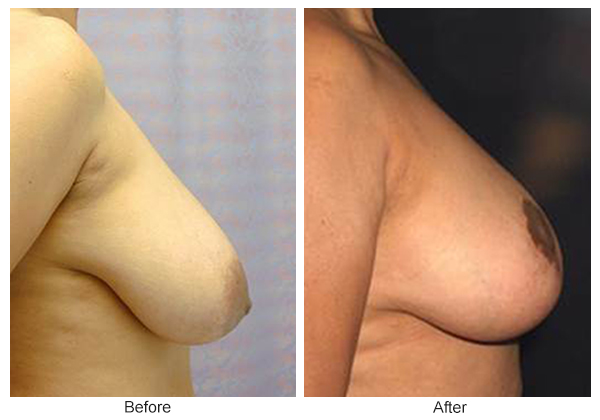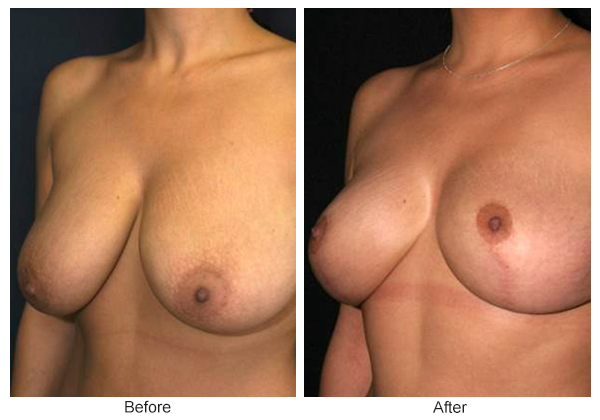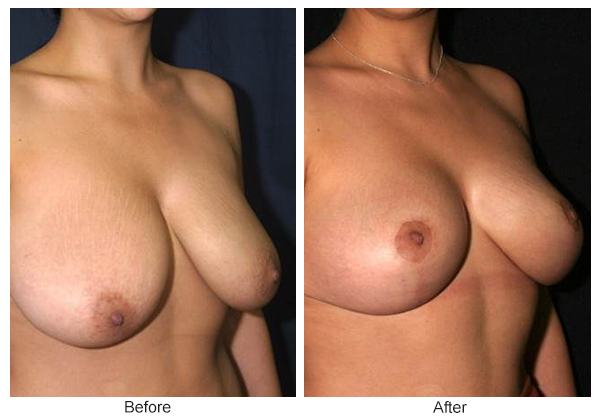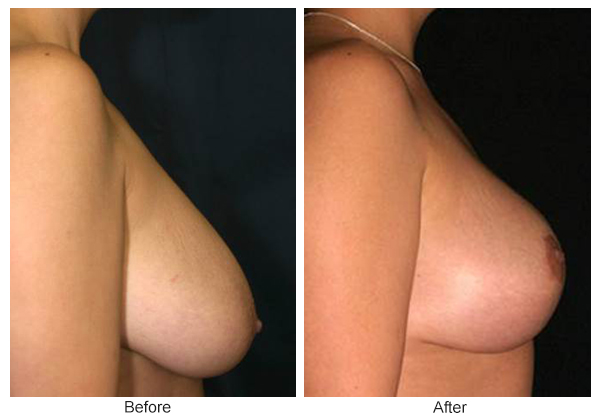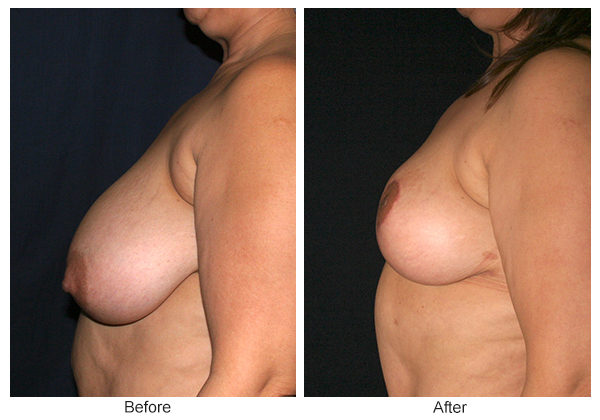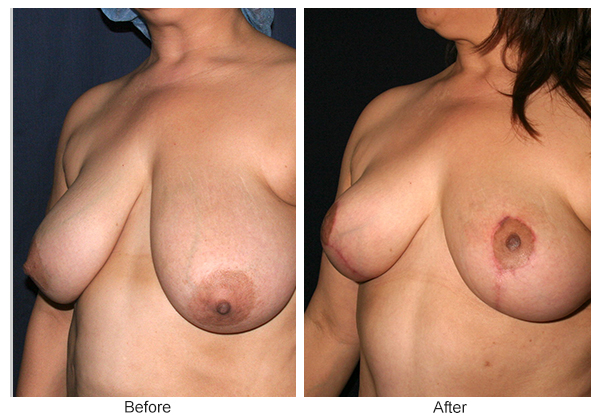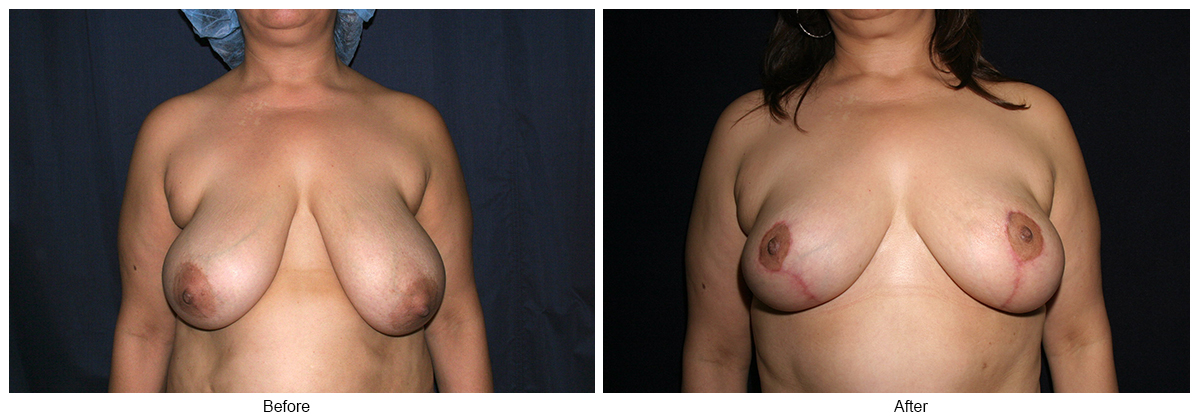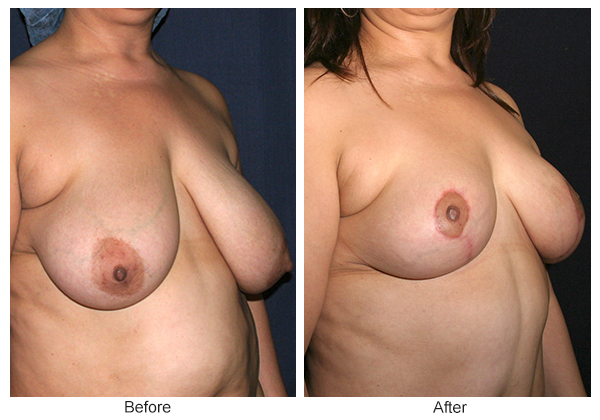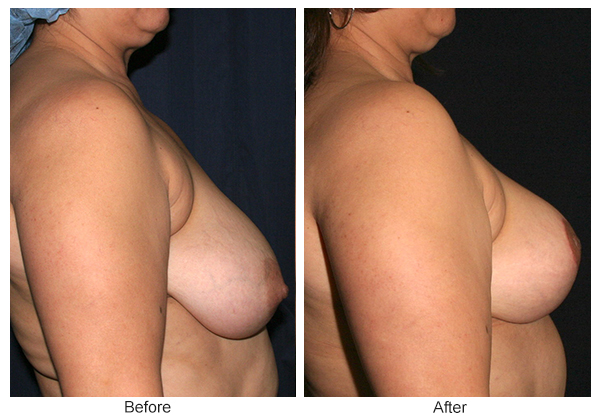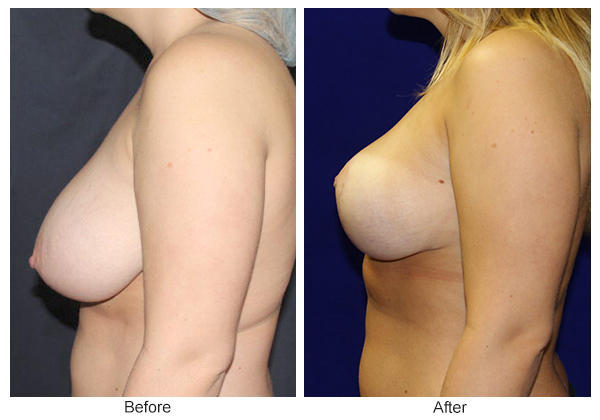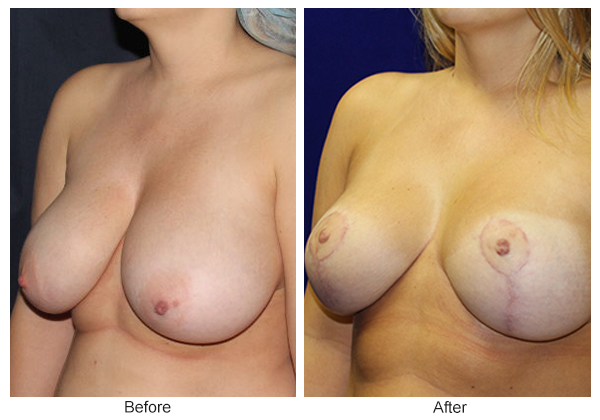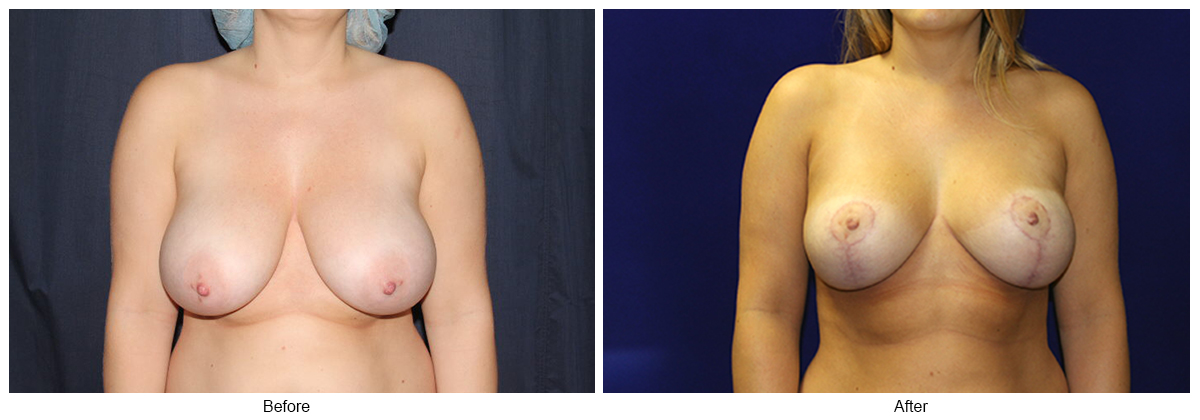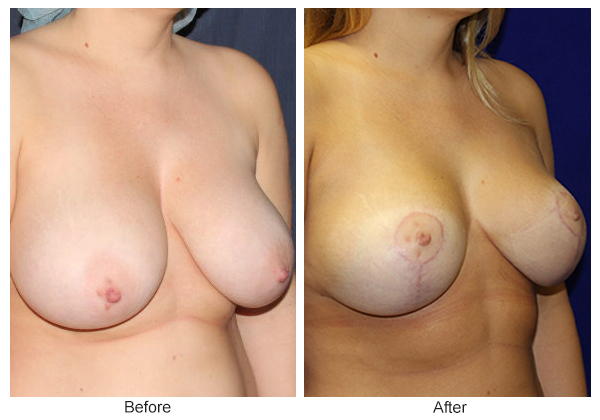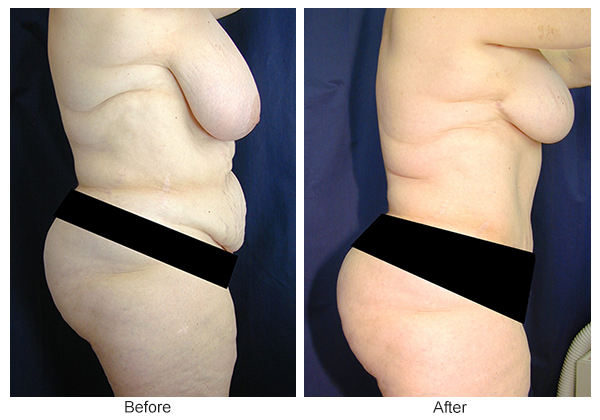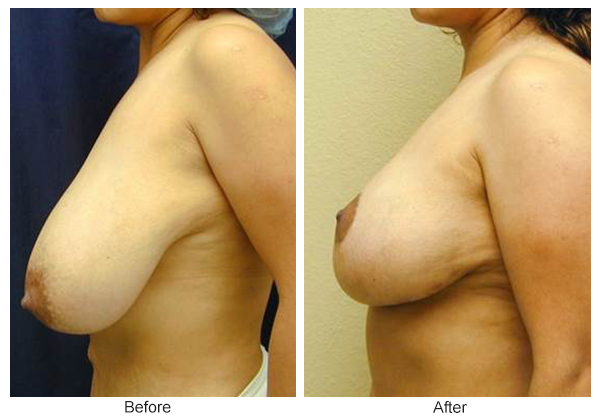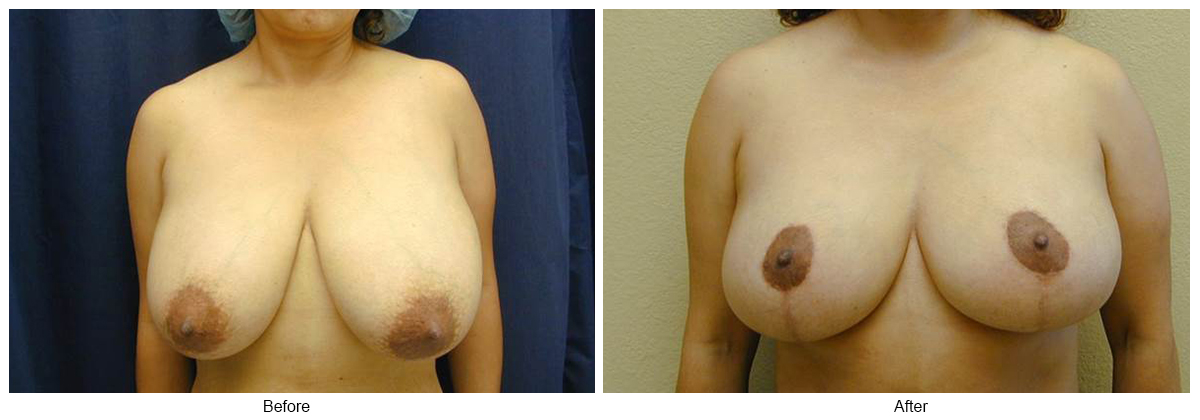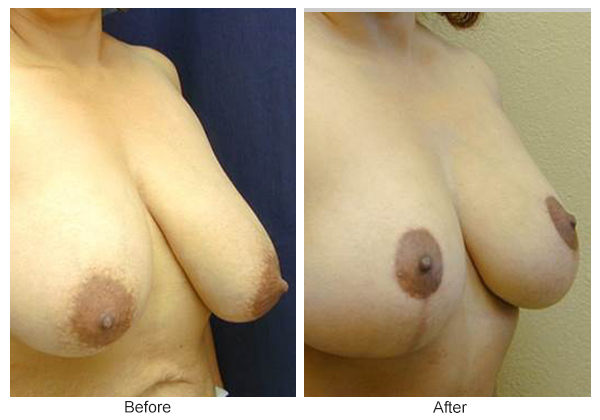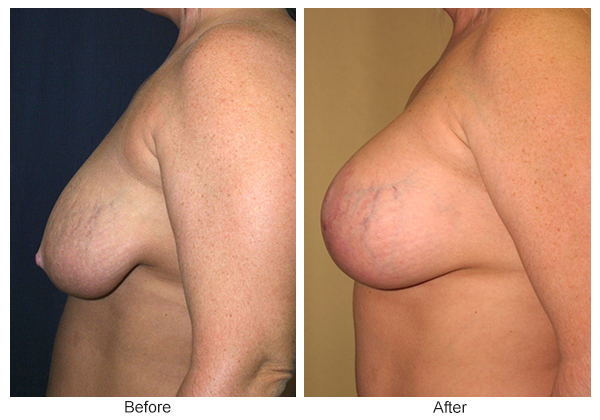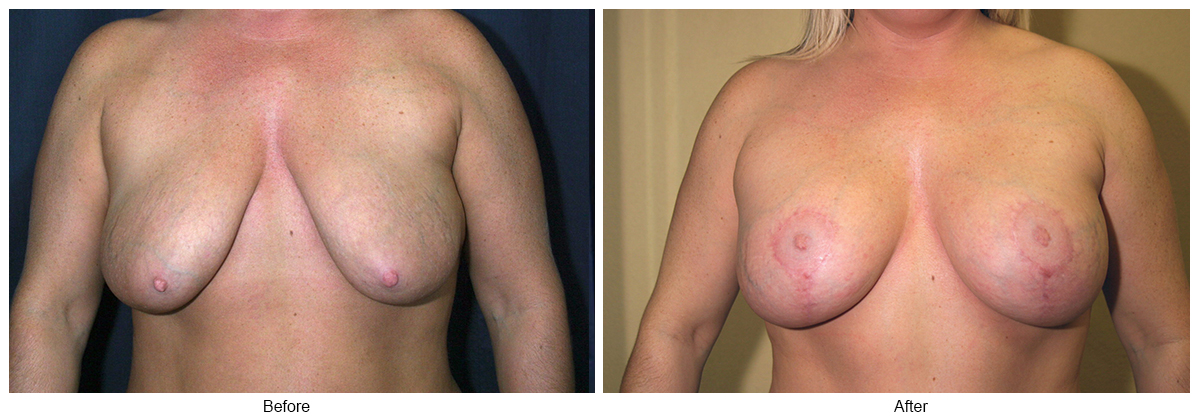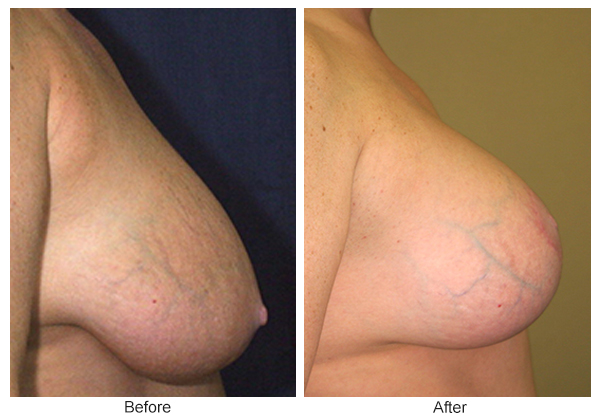Are You Considering Breast Reduction Surgery?
 Women with very large, pendulous breasts may experience a variety of medical problems caused by the excessive weight-from back and neck pain and skin irritation to skeletal deformities and breathing problems. Bra straps may leave indentations in their shoulders. And unusually large breasts can make a woman-or a teenage girl-feel extremely self-conscious.Breast reduction, technically known as reduction mammaplasty, is designed for such women. The procedure removes fat, glandular tissue, and skin from the breasts, making them smaller, lighter, and firmer.
Women with very large, pendulous breasts may experience a variety of medical problems caused by the excessive weight-from back and neck pain and skin irritation to skeletal deformities and breathing problems. Bra straps may leave indentations in their shoulders. And unusually large breasts can make a woman-or a teenage girl-feel extremely self-conscious.Breast reduction, technically known as reduction mammaplasty, is designed for such women. The procedure removes fat, glandular tissue, and skin from the breasts, making them smaller, lighter, and firmer.
It can also reduce the size of the areola, the darker skin surrounding the nipple. The goal is to give the woman smaller, better-shaped breasts in proportion with the rest of her body.If you’re considering breast reduction, this will give you a basic understanding of the procedure- when it can help, how it’s performed, and what results you can expect. It can’t answer all of your questions, since a lot depends on your individual circumstances. Please be sure to ask Dr Tavoussi, if there is anything about the procedure you don’t understand.
The Best Candidates for Breast Reduction Surgery
Breast reduction is usually performed for physical relief rather than simply cosmetic improvement. Most women who have the surgery are troubled by very large, sagging breasts that restrict their activities and cause them physical discomfort.In most cases, breast reduction isn’t performed until a woman’s breasts are fully developed; however, it can be done earlier if large breasts are causing serious physical discomfort. The best candidates are those who are mature enough to fully understand the procedure and have realistic expectations about the results. Breast reduction is not recommended for women who intend to breast-feed.
All Surgeries Carry some Uncertainty and Risk
Breast reduction is not a simple operation, but it’s normally safe when performed by a qualified plastic surgeon. Nevertheless, as with any surgery, there is always a possibility of complications, including bleeding, infection, or reaction to the anesthesia. Some patients develop small sores around their nipples after surgery, these can be treated with antibiotic creams. You can reduce your risks by closely following Dr. Tavoussi’s advice both before and after surgery.
The procedure does leave noticeable, permanent scars, although they’ll be covered by your bra or bathing suit. (Poor healing and wider scars are more common in smokers.) The procedure can also leave you with slightly mismatched breasts or unevenly positioned nipples. Future breast-feeding may not be possible, since the surgery removes many of the milk ducts leading to the nipples.Some patients may experience a permanent loss of feeling in their nipples or breasts. Rarely, the nipple and areola may lose their blood supply and the tissue will die. (The nipple and areola can usually be rebuilt, however, using skin grafts from elsewhere on the body.)
Planning your Surgery
In your initial consultation, it’s important to discuss your expectations frankly with Dr Tavoussi, and to listen to his opinion. Every patient-and every physician, as well-has a different view of what is a desirable size and shape for breasts.The Dr Tavoussi will examine and measure your breasts, and will probably photograph them for reference during surgery and afterwards. (The photographs may also be used in the processing of your insurance coverage.) He will discuss the variables that may affect the procedure-such as your age, the size and shape of your breasts, and the condition of your skin.
You should also discuss where the nipple and areola will be positioned; they’ll be moved higher during the procedure, and should be approximately even with the crease beneath your breasts.Dr Tavoussi will describe the procedure in detail, explaining its risks and limitations and making sure you understand the scarring that will result. Dr Tavoussi will explain the anesthesia he will use, the facility where the surgery will be performed, and the costs. (Some insurance companies will pay for breast reduction if it’s medically necessary, however, they may require that a certain amount of breast tissue be removed. Check your policy, and have Dr Tavoussi write a predetermination letter if required.)
Preparing for Your Surgery
Dr Tavoussi may require you to have a mammogram (breast x-ray) before surgery. You’ll also get specific instructions on how to prepare for surgery, including guidelines on eating and drinking, smoking, and taking or avoiding certain vitamins and medications. Dr Tavoussi would probably suggest that his patients diet before the operation.while you’re making preparations, be sure to arrange for someone to drive you home after your surgery and to help you out for a few days if needed.
Where your Surgery will be Performed
Breast reduction surgery will be performed in our outpatient surgery center. The surgery itself usually takes two to four hours, but may take longer in some cases.
Type of Anesthesia
Breast reduction is nearly always performed under general anesthesia. You’ll be asleep through the entire operation.
The Surgery
Techniques for breast reduction vary, but the most common procedure involves an anchor-shaped incision that circles the areola, extends downward, and follows the natural curve of the crease beneath the breast. Dr Tavoussi removes excess glandular tissue, fat, and skin, and moves the nipple and areola into their new position. He then brings the skin from both sides of the breast down and around the areola, shaping the new contour of the breast. Liposuction may be used to remove excess fat from the armpit area.In most cases, the nipples remain attached to their blood vessels and nerves.
However, if the breasts are very large or pendulous, the nipples and areolas may have to be completely removed and grafted into a higher position. (This will result in a loss of sensation in the nipple and areolar tissue.)Stitches are usually located around the areola, in a vertical line extending downward, and along the lower crease of the breast. In some cases, techniques can be used that eliminate the vertical part of the scar. And occasionally, when only fat needs to be removed, liposuction alone can be used to reduce breast size, leaving minimal scars.
After your Surgery
After surgery, you’ll be wrapped in an elastic bandage dressings. A small tube may be placed in each breast to drain off blood and fluids for the first day or two.You may feel some pain for the first couple of days-especially when you move around or cough-and some discomfort for a week or more. Dr Tavoussi will prescribe medication to lessen the pain.The bandages will be removed a day or two after surgery, though you’ll continue wearing the surgical garment around the clock for several weeks, until the swelling and bruising subside. Your stitches will be removed in one to three weeks.
If your breast skin is very dry following surgery, you can apply a moisturizer several times a day, but be sure to keep the suture area dry.Your first menstruation following surgery may cause your breasts to swell and hurt. You may also experience random, shooting pains for a few months. You can expect some loss of feeling in your nipples and breast skin, caused by the swelling after surgery. This usually fades over the next six weeks or so. In some patients, however, it may last a year or more, and occasionally it may be permanent.
Getting Back to Normal
Although you may be up and about in a day or two, your breasts may still ache occasionally for a couple of weeks. You should avoid lifting or pushing anything heavy for three or four weeks.Dr. Tavoussi will give you detailed instructions for resuming your normal activities. Most women can return to work (if it’s not too strenuous) and social activities in about two weeks. But you’ll have much less stamina for several weeks, and should limit your exercises to stretching, bending, and swimming until your energy level returns. You’ll also need a good athletic bra for support.
You may be instructed to avoid sex for a week or more, since sexual arousal can cause your incisions to swell, and to avoid anything but gentle contact with your breasts for about six weeks.A small amount of fluid draining from your surgical wound, or some crusting, is normal. If you have any unusual symptoms, such as bleeding or severe pain, don’t hesitate to call Dr Tavoussi.
Your New Look
Although much of the swelling and bruising will disappear in the first few weeks, it may be six months to a year before your breasts settle into their new shape. Even then, their shape may fluctuate in response to your hormonal shifts, weight changes, and pregnancy.Dr Tavoussi will make every effort to make your scars as inconspiciuous as possible. Still, it’s important to remember that breast reduction scars are extensive and permanent. They often remain lumpy and red for months, then gradually become less obvious, sometimes eventually fading to thin white lines.
Fortunately, the scars can usually be placed so that you can wear even low-cut tops.Of all plastic surgery procedures, breast reduction results in the quickest body-image changes. You’ll be rid of the physical discomfort of large breasts, your body will look better proportioned, and clothes will fit you better.However, as much as you may have desired these changes, you’ll need time to adjust to your new image-as will your family and friends. Be patient with yourself, and with them. Keep in mind why you had this surgery, and chances are that, like most women, you’ll be pleased with the results.
Breast Lift (Mastopexy)
Patients who have had weight loss or after pregnancy may experience droopy breasts due to loss of breast tissue elasticity. These patients will need breast lift and if there has been loss of volume, breast implants as well.
How does the scar look like?
This depends on the amount of droopiness of the breasts.
- Minimally droopy breasts require minimal lift and therefore small scar which is usually on top of the areola, on the border of the dark areolar skin and it is hardly noticeable.This type of breast lift is called Crescent Lift.
- In Vertical Breast Lift, the scar looks like a lollipop whereby it surrounds the nipple-areolar complex and extends vertically downward.
- The third type of breast lift is called Inverted T or Anchor scar or Wise pattern. The scar is similar to vertical lift with a horizontal segment along the inframammary folds.
Once you are evaluated during your consultation, an accurate diagnosis can be made and an appropriate technique suitable to your condition is recommended.
Would I have a full upper breast poles?
This is a major concern among patients who have lost the fullness and youthful shape of their breasts. Even though with the above techniques, the breast tissues are lifted, in majority of patients due to loss of elasticity of the breast tissue, the loss of upper fullness returns after several months and therefore breast augmentation at the same time is recommended. This will allow restoration of the upper fullness of the breasts. Occasionally, in patients with excessive droopiness, a special technique can be used to achieve upper fullness without breast implants.This is achieved with what is known as inferior pedicle flap technique, which we secure up close to the shoulder area and therefore achieve the desire affect without implants.
Is there a need for a drain placement?
Usually no. On very rare occasions a single drain is placed in each side and removed a day or so later.
How long is the recovery period?
This will initially takes several weeks but majority of patients take one to two weeks off of work. Complete healing is achieved in 6 to 9 months.
Breast Reduction Surgery
This surgery is performed on patients with very large and droopy breasts that are causing neck, shoulder and back pain. Breast reduction will reduce the weight of the breasts as well as lift them to a normal position. The shape of the breasts are also improved. Breasts that are too large in proportion to your body frame heavy, pendulous breasts with nipples and areolas that point downward one breast is much larger than the other back, neck or shoulder pain caused by the weight of your breasts skin irritation beneath your breasts indentations in your shoulders from tight bra straps restriction of physical activity due to the size and weight of your breasts dissatisfaction or self-consciousness about the largeness of your breasts.
Breast reduction can be performed at any age, but plastic surgeons usually recommend waiting until breast development has stopped. Childbirth and breast-feeding may have significant and unpredictable effects on the size and shape of your breasts. Nevertheless, many women decide to undergo breast reduction before having children and feel that they can address any subsequent changes later. If you plan to breast-feed in the future, you should discuss this with your plastic surgeon.
Will my insurance help cover the cost of surgery?
Insurance coverage is sometimes available for breast reduction surgery. Many factors determine your eligibility, including the specific terms of your insurance policy and the amount of breast tissue to be removed. A letter of predetermination may be required by your insurance company prior to surgery. Your plastic surgeon or a staff member in your surgeon’s office will discuss these matters with you.
How Breast Reduction is Performed
We use anchor scar or inverted T technique and most of the time an inferior pedicle flap is used to achieve a more fuller upper pole.
Where are the incisions placed?
The most common method of reducing the breasts involves three incisions. One incision is made around the areola. Another runs vertically from the bottom edge of the areola to the crease underneath the breast. The third incision follows the natural curve of the breast crease. After the surgeon has removed excess breast tissue, fat and skin, the nipple and areola are shifted to a higher position. The areola, which in large breasts usually has been stretched, also is reduced in size. Skin that was formerly located above the nipple is brought down and together to reshape the breast. Liposuction may be used to improve the contour under the arm.
Usually, the nipples and areolas remain attached to underlying mounds of tissue, and this allows for the preservation of sensation. The ability to breast-feed may also be preserved by this method, although this cannot be guaranteed. Skin that formerly was located above the nipple is brought down and together to reshape the breast.
What are some variations to the common breast reduction technique?
There are many variations to the design of the incisions for breast reduction. The size and shape of your breasts, as well as the desired amount of reduction, are factors that will help your plastic surgeon determine the best technique for you. In some instances, it may be possible to avoid the vertical incision that runs from the bottom edge of the areola to the breast crease or the horizontal incision underneath the breast. Rarely, if your breasts are extremely large, the nipples and areolas may need to be completely detached before they are shifted to a higher level. In such a case, you will need to have made the decision to sacrifice sensation and the possibility of breast-feeding in order to achieve your desired breast size.
Understanding Risks
Fortunately, significant complications from breast reduction are infrequent. Every year, many thousands of women undergo successful breast reduction surgery, experience no major problems and are pleased with the results. Anyone considering surgery, however, should be aware of both the benefits and the risks.
I understand that every surgical procedure has risks, but how will I learn more so that I can make an informed decision?
The subject of risks and potential complications of surgery is best discussed on a personal basis between you and your plastic surgeon, or with a staff member in your surgeon’s office. Some of the potential complications that may be discussed with you include bleeding, infection and reactions to anesthesia. Rarely, a patient may require a blood transfusion during the operation. This usually can be anticipated in advance, and your plastic surgeon may, under certain circumstances, advise you to donate your own blood in preparation for surgery.
Following reduction, sometimes the breasts may not be perfectly symmetrical or the nipple height may vary slightly. If desired, minor adjustments can be made at a later time. Permanent loss of sensation in the nipples or breasts may occur rarely. Revisionary surgery is sometimes helpful in certain instances where incisions may have healed poorly. In the unlikely event of injury to or loss of the nipple and areola, they usually can be satisfactorily reconstructed using skin grafts. You can help to lessen certain risks by following the advice and instructions of your plastic surgeon, both before and after
How should I prepare for surgery?
Depending on your age, or if you have a history of breast cancer in your family, your plastic surgeon may recommend a baseline mammogram before surgery and another mammographic examination some months after surgery. This will help to detect any future changes in your breast tissue. Following breast reduction, you will still be able to perform breast self-examination. Breast reduction surgery will not increase your risk of developing breast cancer.
If you are a smoker, you will be asked to stop smoking well in advance of surgery. Aspirin and certain anti-inflammatory drugs can cause increased bleeding, so you should avoid taking these medications for a period of time before surgery. Your surgeon will provide you with additional preoperative instructions. Breast reduction surgery may be performed on an inpatient or outpatient basis. If you are to stay in the hospital or surgical facility, it will most likely be for only one night. Whether you are released the day of surgery or the following day, you will need someone to drive you home and to stay with you for the next day or two.
Your Surgical Experience
The goal of your plastic surgeon and the entire staff is to make your surgical experience as easy and comfortable for you as possible.
What will the day of surgery be like?
Your breast reduction surgery may be performed in a hospital, free-standing ambulatory facility or office-based surgical suite. Usually, a general anesthetic is administered, so that you will be asleep throughout the procedure. When surgery is completed, you will be taken into a recovery area where you will continue to be closely monitored. In many instances, small drain tubes will have been placed in your breasts to help avoid the accumulation of fluids. Gauze dressings will be placed on your breasts and covered with an elastic bandage or surgical bra.
How will I look and feel initially?
The day after surgery, you will be encouraged to get out of bed for short periods of time. After several days, you will be able to move about more comfortably. Straining, bending and lifting must be avoided, however, since these activities might cause increased swelling or even bleeding. You may be instructed to sleep on your back to avoid pressure on your breasts.
Any surgical drains will be removed a day or two after surgery, at which time your dressings may also be changed or removed. You will be instructed to wear a support bra for a few weeks, until the swelling and discoloration of your breasts diminishes. Generally, stitches will be removed in stages over a period of approximately three weeks, beginning about one week after surgery.
You may notice that you feel less sensation in the nipple and areola areas. This usually is temporary. It may, however, take weeks, months or even more than a year before sensation returns to normal. Your breasts may also require some time to assume a more natural shape. Incisions will initially be red or pink in color. They will remain this way for many months following surgery.

